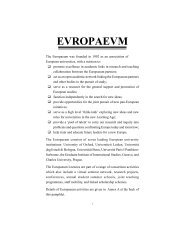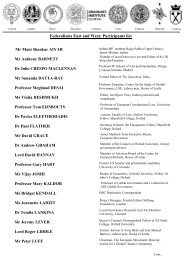to download a Special Report of this meeting - The Europaeum
to download a Special Report of this meeting - The Europaeum
to download a Special Report of this meeting - The Europaeum
Create successful ePaper yourself
Turn your PDF publications into a flip-book with our unique Google optimized e-Paper software.
Strategies and Balance<br />
in our experience working with companies’ governance<br />
structures and philosophies differ, sometimes<br />
radically, from company <strong>to</strong> company.<br />
<strong>The</strong>re are differences <strong>of</strong> ownership structure, and<br />
there are companies that have different attitudes<br />
<strong>to</strong>wards whether they should focus on working<br />
with existing shareholders or look for a broader<br />
stakeholder mix. You have one- versus two-tier<br />
boards, and there is also that big debate, particularly<br />
in the United States, about whether the<br />
Chair should or should not be combined with the<br />
chief executive role.<br />
In our experience, these are legitimate differences.<br />
Governance structures can be done well<br />
in some companies and poorly in others. I think<br />
it is difficult <strong>to</strong> hold <strong>to</strong> the belief that there is<br />
only one way <strong>of</strong> doing corporate governance,<br />
because you may end up with the tail wagging<br />
the dog. You have <strong>to</strong> be wary <strong>of</strong> a rule-driven<br />
system. Box-ticking, as I said earlier, can be<br />
gamed and can lead <strong>to</strong> false positives and false<br />
negatives. For those <strong>of</strong> us that try <strong>to</strong> analyse<br />
companies from an investment perspective, obviously<br />
we need <strong>to</strong> know the extent <strong>to</strong> which companies<br />
comply, but I think if companies explain<br />
why they don’t, we need <strong>to</strong> be listening with very<br />
open ears and possibly be willing <strong>to</strong> accept <strong>to</strong> the<br />
explanation.<br />
This ultimately speaks <strong>to</strong> the point that there<br />
is room for both rules and principles, but at the<br />
end <strong>of</strong> the day you need <strong>to</strong> focus on a principlebased<br />
system, as principles will ultimately trump<br />
rules. <strong>The</strong> principles that I <strong>of</strong>fer are the ones we<br />
use in the S&P criteria, which we borrowed from<br />
the OECD corporate governance guidelines: companies<br />
should be driven by fairness, transparency,<br />
accountability, and responsibility. <strong>The</strong> point<br />
is, if you are looking at disparate structures, you<br />
need <strong>to</strong> put these principles as the lens in front<br />
<strong>of</strong> your eyes, so that you can interpret different<br />
structures through these principles. One would<br />
hope that these principles, even though we may<br />
differ about specific nuances <strong>of</strong> corporate governance,<br />
would be relatively consistently valued<br />
from culture <strong>to</strong> culture around the world.<br />
To bring <strong>this</strong> home, then: the conclusion that<br />
I would like <strong>to</strong> leave with you is that corporate<br />
governance is a risk fac<strong>to</strong>r. <strong>The</strong>re is a linkage <strong>of</strong><br />
governance risk <strong>to</strong> the concerns <strong>of</strong> inves<strong>to</strong>rs and<br />
D&O insurers, and there is the need <strong>to</strong> try <strong>to</strong><br />
understand these qualitative and difficult-<strong>to</strong>understand<br />
issues more systematically and<br />
objectively. Laws and codes can provide a positive<br />
discipline, but there is more <strong>to</strong> it than simply<br />
that. Equally, and linked <strong>to</strong> <strong>this</strong> mission, is that<br />
governance is not a one-size-fits-all concept. You<br />
need <strong>to</strong> assess companies on a case-by-case basis<br />
and I would argue that the best way <strong>to</strong> do it is<br />
not just <strong>to</strong> tick boxes, but <strong>to</strong> try <strong>to</strong> do <strong>this</strong> interactively,<br />
<strong>to</strong> connect <strong>to</strong> and provide the best exposure<br />
<strong>to</strong> culture (again, principles prevailing over<br />
rules). Finally, governance is not an end un<strong>to</strong><br />
itself. <strong>The</strong> key is <strong>to</strong> keep in mind how it helps or<br />
inhibits companies <strong>to</strong> oversee risks and build<br />
sustainable competitive advantage; it is not a single<br />
set <strong>of</strong> rules in isolation from each other. It<br />
has <strong>to</strong> be linked <strong>to</strong> the enterprise as a whole, and<br />
ultimately it is about trust – and trust is not<br />
something that can be legislated.<br />
How do you strike<br />
David Jackson<br />
the balance<br />
Company<br />
between prescriptive<br />
and enabling strate-<br />
Secretary, BP<br />
gies I will discuss later<br />
why <strong>this</strong> is such a timely<br />
question. But first, why is<br />
the question being asked<br />
Let’s look at governance in the UK environment<br />
and then broaden it out in<strong>to</strong> Europe.<br />
At the time I was asked <strong>to</strong> make a small contribution<br />
<strong>to</strong> the discussion <strong>to</strong>day, a survey<br />
appeared on my desk co-sponsored by Allen &<br />
Overy and MORI, with the headline: “Many<br />
European senior executives are still fearful <strong>of</strong> an<br />
Enron-like meltdown”. Only half <strong>of</strong> European<br />
executives believe corporate governance reforms<br />
have brought about a positive change in behaviour.<br />
<strong>The</strong> costs <strong>of</strong> compliance have substantially<br />
increased.” <strong>The</strong> numbers in the survey don’t<br />
quite reflect the headline, but there is an interesting<br />
line in the report, saying that what is significant<br />
about <strong>this</strong> response is, despite the significant<br />
increase in regulation, there is still work <strong>to</strong><br />
be done <strong>to</strong> convince executives that regulation<br />
has achieved what it is meant <strong>to</strong> achieve, i.e. a<br />
significant reduction in the likelihood <strong>of</strong> corporate<br />
fraud.<br />
In the worst <strong>of</strong> all worlds, regulation merely<br />
achieves an increase in the cost <strong>of</strong> compliance<br />
and becomes a distraction for senior management.<br />
According <strong>to</strong> the results <strong>of</strong> the survey, the<br />
jury is still out on the effectiveness <strong>of</strong> corporate<br />
governance reforms; unless or until the majority<br />
<strong>of</strong> those at a senior level who have <strong>to</strong> implement<br />
these reforms, buy in<strong>to</strong> them, there is only so<br />
much that can be achieved.<br />
One <strong>of</strong> the other issues raised in the survey is<br />
the amount <strong>of</strong> time the spent on corporate governance<br />
issues. Apparently “shareholders must ask<br />
themselves whether the 25% <strong>of</strong> the time spent by<br />
their direc<strong>to</strong>rs on corporate governance issues is<br />
<strong>to</strong>o much or not enough.” <strong>The</strong> right answer will<br />
depend on each company. It will be different for<br />
a CEO or non-executive. <strong>The</strong> wider issue is<br />
whether we are creating a corporate culture <strong>of</strong><br />
compliance and box-ticking which distracts<br />
boards from the task <strong>of</strong> moving the business forward.<br />
I would characterize <strong>this</strong> as the grumpy<br />
business approach <strong>to</strong> governance: governance<br />
23
















